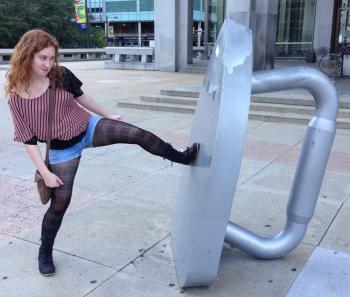Serendip is an independent site partnering with faculty at multiple colleges and universities around the world. Happy exploring!
Playing with Flanagan

Flanagan defines play, at one point, as separated from reality. This makes me wonder- did we ever truly play in the city? I know for sure that I never felt separated from reality while in Philadelphia (or indeed any other city). If anything, being in the city felt more realistic, more consequential than anything else I do in my life. This makes me unsure of whether or not to agree with what Flanagan writes about.
However, Flanagan also offers up a definition for “critical play”. She defines it as “creat[ing] or occupy[ing] play environments and activities that represent one or more questions about aspects of human life… Criticality in play can be fostered in order to question an aspect of a game’s ‘content,’ or an aspect of a play scenario’s function that might otherwise be considered a given or necessary… Critical play is characterized by a careful examination of social, cultural, political, or even personal themes that function as alternates to popular play spaces.” Perhaps this definition is a bit closer to the experiences I’ve had in the city. Another issue I was trying to work through while reading Flanagan was her section about “technology”. I don’t believe that my play in the city required any technology. I found that simply walking around was enough to feel that I was playing. This leads me to believe that my main method of playing in the city is by using subversion.
After seeing the Magic Gardens, my group was very intent on one set goal: eating lunch at Ishkabibble’s, a small restaurant that sells cheesesteaks and about nothing else. We were so intent that we skipped over playing on a playground completely, but we all noticed, only a few blocks before we reached the restaurant, a used bookstore. Almost every person in our group pointed it out immediately, which we took as a sign that we should stop in. It was one of those stores that seem bigger on the inside than the outside. We wandered around for well over half an hour, completely forgetting our hunger. If our game was finding Ishkabibble’s (which none of us had ever actually been to), then we broke the rules of the game (a moderate form of subversion) by going off track and visiting the bookstore.

I’ve been into Philadelphia five times since coming to Bryn Mawr, and on almost every trip, I’ve visited the Board Game Art Park. On my most recent trip, I took a picture of my kicking down an iron Monopoly piece. My friend and I joked that this was symbolic of my kicking down the patriarchy. Looking back, I realize now that I had subconsciously engaged in Flanagan’s definitions of ‘critical play’ and ‘subversion’. Subversion is described as “an action, plan, or activity intended to undermine an institution, event, or object.” Critical play “is characterized by a careful examination of social, cultural, political, or even personal themes that function as alternates to popular play spaces.” I was rebelling against the ‘traditional gender roles’ that the iron symbolized, and so making a statement with the picture I took (and made my profile picture on Facebook, later). Although I was having fun, playing in the Park, I was also examining and defying a social theme that runs throughout our culture.
That experience would more specifically be under Flanagan’s “activist game” category. This specifies that there is a desired outcome that would come from the playing of the game. In this case, my wanted outcome would be educating people who see the picture about the rights of women.



Comments
At the beginning, Natschall
At the beginning, Natschall states some questions about Flanagan's definition of "play" and "technology", and then answers them by combining her understanding and her experience during her trips to Philadelphia. She writes many vivid details of her trips which are all related to the content of Flanagan's book. Besides, I am also interested in the Broad Game Art Park that she mentions, and I want to go there to have a look.
Natschall begins her post
Natschall begins her post with Flanagan’s loose definition of play. Then, she responds to this definition by asking several questions. Natschall then answers these questions by referencing Flanagan’s definitions of “critical play” and “technology” and agreeing with them. After fully exploring these definitions, Natschall absorbs them into her own experience. She writes of both the restaurant Ishkabibble and the Board Game Art Park. She uses both of these experiences to support Flanagan’s notion of “critical play.” Throughout her recollections of these experience, Natschall uses more of Flanagan’s terms and shows how she participated in Flanagan’s theories.